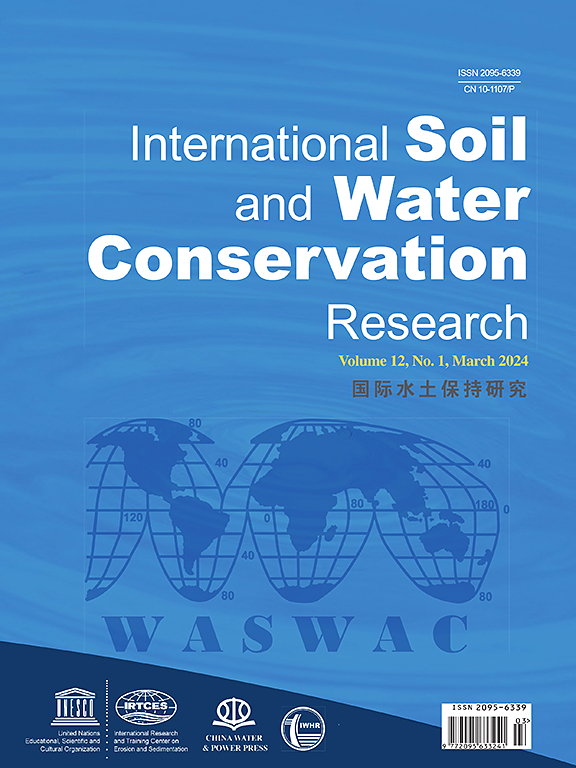Estimation of soil moisture of a high Andean wetland ecosystem (Bofedal) with geo-radar data and In-Situ measurements, Ayacucho - Peru
IF 7.3
1区 农林科学
Q1 ENVIRONMENTAL SCIENCES
International Soil and Water Conservation Research
Pub Date : 2024-06-17
DOI:10.1016/j.iswcr.2024.06.003
引用次数: 0
Abstract
High Andean ecosystems within microbasins serve as crucial areas for water recharge, containing both surface and subsurface moisture. However, these ecosystems are currently under threat due to overgrazing, degradation, and the impacts of climate change. The objective is to validate the subsoil moisture of bofedal estimated using ground-penetrating radar (GPR) data in comparison to in-situ measurements obtained with a soil moisture meter (SMM) in the Apacheta microbasin of the Ayacucho region. The validation method involves comparing soil moisture values obtained with the SMM, with the estimated dielectric permittivity (DP) values from GPR surveys along four transects (T) in a bofedal. Reflected wave amplitude data are converted to DP values to identify water pockets () and saturated soil moisture (). An analysis of the determination coefficient R2 and the Kappa index was conducted between both groups of bofedal subsoil moisture data along the four surveyed transects at depths ranging from 0 to 24 cm that contain water and saturated moisture. T1 contains a volume of (47.85 %), T2 has (46.6 %), T3 lacks water (40.8 %), and T4 holds (31.45 %). The correlation of DP data with SMM for T1 (, T2 (, T3 ( y T4 ( implies that the SMM measurements significantly explain the estimated DP. Moreover, the kappa test demonstrated good agreement reliability between both observations made with GPR and SMM, with , indicating that the GPR method for measuring subsoil moisture is acceptable with an 87.5% confidence level.
基于地理雷达数据和原位测量的高安第斯湿地生态系统(Bofedal)土壤水分估算,秘鲁
微盆地内的安第斯高原生态系统是水补给的关键区域,包含地表和地下水分。然而,由于过度放牧、退化和气候变化的影响,这些生态系统目前正受到威胁。目的是验证使用探地雷达(GPR)数据估计的bofedal的底土湿度,并将其与使用土壤湿度仪(SMM)在阿亚库乔地区Apacheta微盆地获得的原位测量结果进行比较。验证方法包括将SMM获得的土壤湿度值与GPR沿着四个断面(T)测量的估计介电介电常数(DP)值进行比较。将反射波振幅数据转换为DP值,用于识别水袋(70<DP<81)和饱和土壤水分(10<DP<40)。在0 ~ 24 cm含水和饱和水分的4个调查样带上,对两组土壤水分测定系数R2和Kappa指数(κ)进行了分析。T1容积为1.16 m3 (47.85%), T2容积为0.98m3 (46.6%), T3缺水(40.8%),T4容积为0.63m3(31.45%)。DP数据与SMM在T1 (R2=0.801)、T2 (R2=0.949)、T3 (R2=0.837)和T4 (R2=0.842)的相关性表明,SMM测量值显著解释了估计的DP。此外,kappa检验表明GPR和SMM观测值之间具有良好的一致性信度,κ=0.763;[95%CI:0.471−1.055],表明GPR测量地下土壤湿度的方法是可以接受的,置信水平为87.5%。
本文章由计算机程序翻译,如有差异,请以英文原文为准。
求助全文
约1分钟内获得全文
求助全文
来源期刊

International Soil and Water Conservation Research
Agricultural and Biological Sciences-Agronomy and Crop Science
CiteScore
12.00
自引率
3.10%
发文量
171
审稿时长
49 days
期刊介绍:
The International Soil and Water Conservation Research (ISWCR), the official journal of World Association of Soil and Water Conservation (WASWAC) http://www.waswac.org, is a multidisciplinary journal of soil and water conservation research, practice, policy, and perspectives. It aims to disseminate new knowledge and promote the practice of soil and water conservation.
The scope of International Soil and Water Conservation Research includes research, strategies, and technologies for prediction, prevention, and protection of soil and water resources. It deals with identification, characterization, and modeling; dynamic monitoring and evaluation; assessment and management of conservation practice and creation and implementation of quality standards.
Examples of appropriate topical areas include (but are not limited to):
• Conservation models, tools, and technologies
• Conservation agricultural
• Soil health resources, indicators, assessment, and management
• Land degradation
• Sustainable development
• Soil erosion and its control
• Soil erosion processes
• Water resources assessment and management
• Watershed management
• Soil erosion models
• Literature review on topics related soil and water conservation research
 求助内容:
求助内容: 应助结果提醒方式:
应助结果提醒方式:


